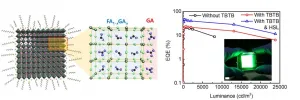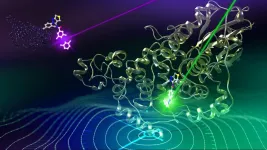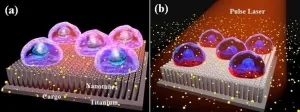Highly efficient perovskite light-emitting diodes for next-generation display technology
Perovskite LEDs with the world's highest efficiency (EQE = 23.4%) -- Seoul National University and University of Pennsylvania
2021-01-25
(Press-News.org) Research team at Seoul National University (Prof. Tae-Woo Lee) and University of Pennsylvania (Prof. Andrew M. Rappe) developed perovskite light-emitting diodes (PeLEDs) with an external quantum efficiency (EQE) of 23.4%. The research results were published in Nature Photonics, which is the world-renowned international academic journal, on January 4th (Title: Comprehensive defect suppression in perovskite nanocrystals for high-efficiency light-emitting diodes).
Metal halide perovskites have very narrow spectral emission, excellent color purity, low material cost, and wide and easy color-tunability. Based on these advantages, perovskites are considered as a promising high color purity light emitter which can replace the conventional organic and inorganic quantum dot (QD) light emitters in displays and solid-state lighting technologies. Especially, perovskite is the only one emitter which can meet the standard of REC.2020. Therefore, perovskite is expected to contribute to the future ultra-high-definition television (UHD-TV) technology.
Since professor Tae-Woo Lee reported the PeLEDs with EQE of 8.53% which was comparable to that of phosphorescent organic light-emitting diode (LED) in Science in 2015, electroluminescence efficiencies of PeLEDs have been dramatically increased. After the Science paper, professor Tae-Woo Lee has lead the research fields of PeLEDs and recently achieved a EQE of 23.4% which was published in Nature Photonics. This EQE value is the highest efficiency in PeLEDs to date and even surpasses the highest EQE in InP-based green-emitting QD-LEDs (EQE = 13.6%). This improvement of EQE in PeLEDs is much faster than that in QD-LEDs which took 20 years to achieve EQE of 20% since it was first reported. These highlight the possibility of a commercialization of the perovskite emitters in industrial displays and solid-state lighting technologies.
Perovskites have severe problems to emit light at room temperature; small exciton binding energy induces direct dissociation of charge carriers and results in low luminescence efficiencies. To overcome this intrinsic problem, researchers have devoted to synthesizing colloidal perovskite nanocrystals which have a size of several nanometers (1 billionth of a meter). In such a small dimension, charge carriers can be spatially confined and can have high binding energy. However, due to the small size and concomitant high surface-to-volume ratio, perovskite nanocrystals have large surface defects. Furthermore, surface organic ligands are easily detached from the nanocrystal surfaces due to the dynamic binding nature, which induces many defects on the nanocrystal surfaces. Therefore, new strategy to effectively passivate the defects should be needed.
To solve these problems, Seoul National University research team led by Professor Tae-Woo Lee proposed a comprehensive strategy which introduces guanidinium organic cations into the conventional formamidinium-based perovskite nanocrystals. The introduced guanidinium cations controlled the defects both inside the nanocrystals and on the surfaces, and simultaneously confined the charge carriers more effectively inside the nanocrystals. As a result, perovskite nanocrystals achieve very high photoluminescence quantum efficiency (PLQE>90%) in both films and solutions. In addition, research team removed residual defects on nanocrystal surfaces by using a halide-based defect passivation agent, 1,3,5-tris(bromomethyl)-2,4,6-triethylbenzene (TBTB). With these comprehensive strategies, the research team demonstrated PeLEDs with the world's highest EQE (23.4%) and current efficiency (108 cd A-1). This is the highest device efficiency in PeLEDs to date and even surpasses the highest efficiency in InP-based green emitting QD-LEDs (EQE = 13.6%).
A collaborative research team at University of Pennsylvania, led by Professor Andrew M Rappe, investigated a detailed defect suppression mechanism through the density functional theory (DFT) calculation. The collaborative research team investigated the mechanism that guanidinium can be incorporated into the nanocrystals in small concentrations (~10%), above which guanidinium migrates to the surface outermost layer of nanocrystals. Furthermore, the collaborative research team studied how this guanidinium doping passivates the defects both inside the nanocrystals and on the surfaces. In addition, collaborative research team investigated the principle that halide-based TBTB material passivates the residual defects on the surfaces.
Prof. Tae-Woo Lee said, "We have proposed a comprehensive strategies to passivate the defects and increase the radiative recombination in the perovskite nanocrystals for demonstrating extremely efficient PeLEDs". "We expect that our work contributes to the commercialization of PeLEDs, as well as suggests a way to increase the luminescence efficiency of the PeLEDs." said Tae-Woo.
INFORMATION:
This work was funded by the National Research Foundation of Korea (NRF) grant funded by the Korea government.
[Attachments] See images for this press release:

ELSE PRESS RELEASES FROM THIS DATE:
2021-01-25
The Nagoya University Institute of Transformative Bio-Molecules (WPI-ITbM) research team of Designated Associate Professor Tsuyoshi Hirota, Postdoctoral Fellow Simon Miller, Professor Kenichiro Itami and graduate student Tsuyoshi Oshima (Research Fellowship for Young Scientists, JSPS), in collaboration with the group of Professor Ben Feringa and Postdoctoral Fellow Dušan Kolarski of Groningen University in the Netherlands, have achieved a world first: fully reversible manipulation of the period of the circadian clock using light, by exchanging part of a compound with a light-activated switch.
Waking in the ...
2021-01-25
Greater sports participation among Aboriginal and Torres Strait Islander children is linked with better academic performance, according to new research from the University of South Australia.
Conducted in partnership with the University of Sydney and the University of Technology Sydney, the world-first study found that Aboriginal and Torres Strait Islander children who played organised sports every year over four years, had numeracy skills which were advanced by seven months, compared to children who did less sport.
The study used data from four successive waves of Australia's Longitudinal Study of Indigenous Children, following 303 students (with a baseline age of five to six years old) to assess cumulative sports participation against ...
2021-01-25
A world-first discovery by researchers at Monash University and The University of Queensland could lead to faster and more effective treatments for chronic health complications, such as cardiovascular disease and cancer, with 'fluorescent' in vivo biosensors.
The research team, led by Dr Simon Corrie from Monash University's Department of Chemical Engineering and the ARC Centre of Excellence in Convergent Bio-Nano Science and Technology, took an antibody that binds EGFR (epidermal growth factor receptor) proteins and engineered it to monitor the concentration of EGFR proteins in serum solutions over time.
Co-authors of the paper, published in ACS Sensors, are Dr Christian Fercher, Dr Martina ...
2021-01-25
They are among the largest predators ever to walk the Earth, but experts have discovered that some baby tyrannosaurs were only the size of a Border Collie dog when they took their first steps.
The first-known fossils of tyrannosaur embryos have shed light on the early development of the colossal animals, which could grow to 40 feet in length and weigh eight tonnes.
A team of palaeontologists, led by a University of Edinburgh researcher, made the discovery by examining the fossilised remains of a tiny jaw bone and claw unearthed in Canada and the US.
Producing 3D scans of the delicate fragments revealed that they belonged to baby tyrannosaurs ...
2021-01-25
Scientists from UNSW Sydney have developed a ceramic-based ink that may allow surgeons in the future to 3D-print bone parts complete with living cells that could be used to repair damaged bone tissue.
Using a 3D-printer that deploys a special ink made up of calcium phosphate, the scientists developed a new technique, known as ceramic omnidirectional bioprinting in cell-suspensions (COBICS), enabling them to print bone-like structures that harden in a matter of minutes when placed in water.
While the idea of 3D-printing bone-mimicking structures is not new, this is the first time such material can be created at room temperature - complete with living cells ...
2021-01-25
The carbon footprint of plastic production for initial use is greater than the global warming impact of the entire process used for medical device reprocessing Use of reprocessed devices is environmentally superior to use of original products in 13 of 16 categories evaluatedReprocessing found to advance "circular economy," a key strategy for reaching the UN Sustainability GoalsLCA offers evidence showing that in order to reduce greenhouse gas emissions and honor the Paris Climate Agreement, EU Member States must opt-in to EU Medical Device Regulation (MDR)'s reprocessing/remanufacturing provisions
[Berlin / Washington, ...
2021-01-25
Large-scale production of vegetables and fruit in Spain with intensive plastic consumption in its greenhouse industry is believed to have leaked microplastic contaminants since the 1970s into the surrounding Mediterranean seagrass beds. This is shown in a new study where researchers have succeeded in tracing plastic pollution since the 1930s and 1940s by analyzing seagrass sediments.
About half of Sweden's cucumbers and a fifth of the tomatoes in Sweden are currently imported from Spain according to the Swedish Board of Agriculture. A special area in Spain where large-scale vegetable cultivation ...
2021-01-25
Overview:
A research team at the Department of Mechanical Engineering at Toyohashi University of Technology developed a nanosecond pulse laser-assisted photoporation method using titanium-oxide nanotubes (TNTs) for highly efficient and low-cost intracellular delivery. The proof of concept for the possibility of intracellular delivery after irradiation with nanosecond pulse laser on TNTs was validated. TNTs were formed on titanium sheets using the electrochemical anodization technique at different voltages and times. HeLa - human cervical cancer cells were cultured in the nanotubes and submerged in a solution of biomolecules. After cells were exposed to nanosecond pulse laser, we successfully delivered ...
2021-01-25
There isn't much in Kamchatka, a remote peninsula in northeastern Russia just across the Bering Sea from Alaska, besides an impressive population of brown bears and the most explosive volcano in the world.
Kamchatka's Shiveluch volcano has had more than 40 violent eruptions over the last 10,000 years. The last gigantic blast occurred in 1964, creating a new crater and covering an area of nearly 100 square kilometers with pyroclastic flows. But Shiveluch is actually currently erupting, as it has been for over 20 years. So why would anyone risk venturing too close?
Researchers from Washington University in St. Louis, including Michael Krawczynski, assistant professor of earth and planetary sciences in Arts & Sciences and graduate student ...
2021-01-25
Abusive bosses may retain their positions by taking superficial steps to repair their social images following outbursts, without acting meaningfully to change their behaviors, according to research led by a University of Wyoming business management expert.
Shawn McClean, an assistant professor in UW's College of Business, joined colleagues from the University of Iowa, the University of Nebraska-Lincoln and Texas A&M University in conducting the research, which appears in the journal Personnel Psychology. Their study also was featured in Harvard Business Review, a preeminent business magazine.
"Our study shows that supervisors are often driven by simply repairing their social image rather than ...
LAST 30 PRESS RELEASES:
[Press-News.org] Highly efficient perovskite light-emitting diodes for next-generation display technology
Perovskite LEDs with the world's highest efficiency (EQE = 23.4%) -- Seoul National University and University of Pennsylvania






